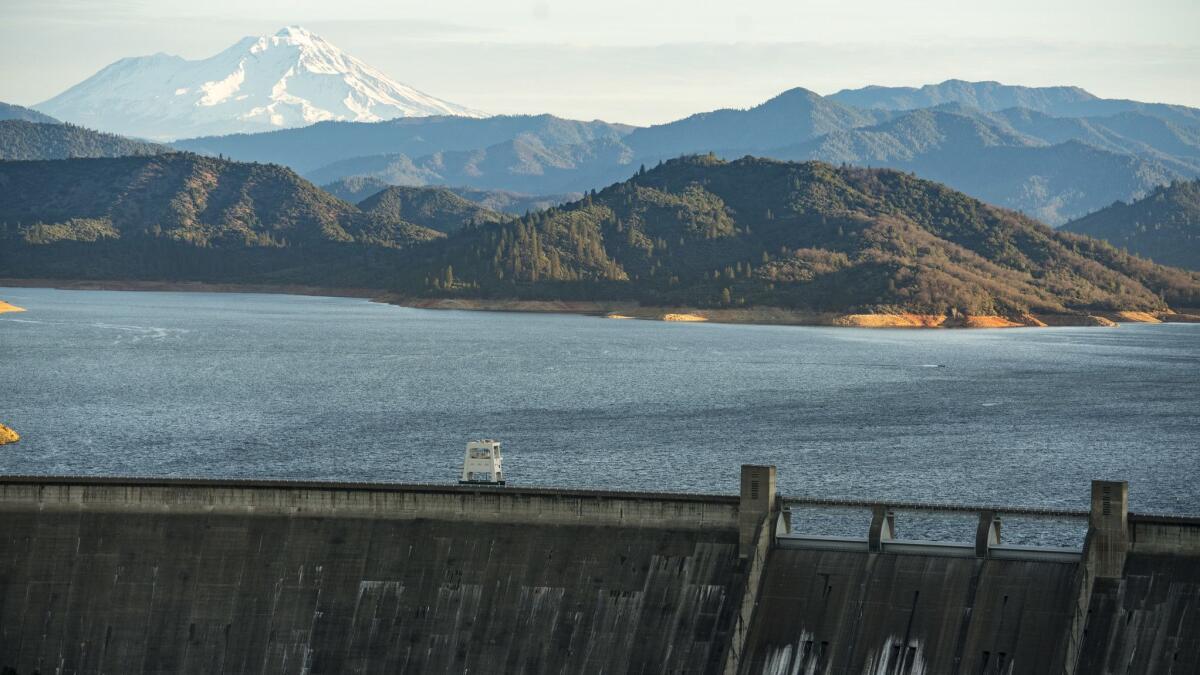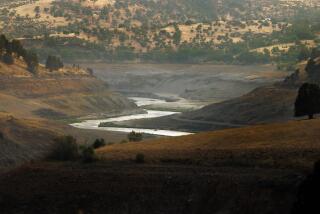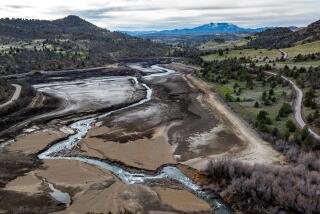Op-Ed: Why California should turn down Trump’s offer to raise Shasta Dam

If the Trump administration wanted to increase California’s water supply by the most cost-effective means possible, it would immediately drop its attempt to raise Shasta Dam by 18.5 feet.
It would instead put $1.5 billion — the cost of the proposed Shasta enlargement, in 2019 dollars — toward a completely different approach to water supply: watershed and forest restoration. Not only would such restoration add to the state’s water supply, it would help California deal with mega-fires, flooding and climate change.
But the Trump administration isn’t interested in rationally dealing with water scarcity in California. Instead, it sees Shasta as, in the words of Ron Stork, senior policy advocate at Friends of the River, “a political dam,” with payoffs in favors to big agriculture and blue-state provocation.
The justification for the Shasta project is scant.
The project’s main backer is the Westlands Water District, headquartered in Fresno, the nation’s largest agricultural irrigation district. Westlands is notorious for poisoning the nearby Kesterson Wildlife Refuge with selenium from its drained fields, resulting in deaths and grotesque deformities of migratory waterfowl in the 1980s. It’s also known for its unabashed use of money and political ties to steer the state’s water policies.
The several hundred families who own Westland’s 1,000-plus square miles of farmland have zealously cultivated Republican, and to some degree Democratic, connections in the Central Valley and in Washington. The most recent success: David Bernhardt, who as Westlands’ lobbyist tried to weaken environmental restrictions in the Sacramento-San Joaquin River Delta, has been nominated to head the Interior Department.
Bernhardt, already the acting Interior secretary, surely buttresses the Trump administration’s reawakened interest in Shasta after decades of unsuccessful attempts by Westlands to gain approval for the project.
Shasta is the cornerstone of the federal water system in California, the Central Valley Project. Enlarging it, however, would violate a state law, a complication that may engulf the project in lawsuits. For now, the Interior Department has $20 million to plan for a raised dam.
California officials oppose the project because it would inundate a spectacular reach of the McCloud River, legendary for its trout fishing, that is protected by the California Wild and Scenic Rivers Act. Westlands has tried to blur the conflict by buying the 3,000-acre Bollibokka Fishing Club, a historic river property that would be submerged if the project proceeds. The Native American Winnemem Wintu tribe also objects, in its case because raising the dam would drown the last of the tribe’s remaining sacred sites.
The justification for the Shasta project is scant. It would produce only an estimated average annual increase in water yield of 70,000 acre-feet, a hundredth of the total amount of water that moves through the state each year via the Central Valley Project. And in years when the reservoir isn’t full — most of the time — Westlands would receive no additional water from the enlarged dam at all.
Westlands officials argue that raising the dam would benefit endangered salmon by increasing the amount of cold water downstream from the dam that the fish depend on, but state and federal scientists reject this claim. They point out that a bigger dam would divert more water from the already depleted Sacramento River, further compromising the health of salmon and the Sacramento-San Joaquin River Delta.
Many methods would increase the state’s water yield more cost-effectively than the dam raise — among them are water recycling, groundwater storage, stormwater capture and conservation. But the most broadly beneficial approach is restoration of the state’s degraded forests and watersheds, which are overgrown with trees as a result of more than a century of fire suppression. In the climate change era, those forests are further weakened by bark beetles, and they fuel many of the mega-fires that now plague the state.
Restoration returns forests to a healthy ratio of trees to acreage by removing immature trees and shrubs and carrying out prescribed burns. The older trees that remain have sufficiently thick barks to withstand fires; indeed, fires often die out when they reach restored areas. Healthy watersheds deter flooding by absorbing water. They are vital components in fighting climate change, as carbon that otherwise would escape into the atmosphere is sunk in soil and mature trees. In the event of fire, restored forests deter soil erosion that causes sediment to clog rivers, reservoirs and water treatment plants.
Enter the Fray: First takes on the news of the minute »
Perhaps least understood, restoring forests contributes to the state’s water supply. Roger Bales, a hydrologist at UC Merced, has shown that by removing young trees that otherwise send water into the atmosphere through evapotranspiration, restored forests capture more water that can end up in reservoirs. More snow reaches the ground, where it melts and percolates into the soil instead of evaporating, and the branches of taller, multi-canopied forests create enough turbulence to capture more water from mist and clouds.
If key Northern California watersheds are restored, Laurie Wayburn, chief executive of the Pacific Forest Trust, told me, “you’ll get a lot more water than simply by raising a dam.”
Though taxpayers would pay a major share of raising Shasta Dam and of restoring California watersheds and forest, Westlands would be the dam’s main beneficiary, whereas forest restoration benefits all the state’s residents. That’s why, despite the raise’s low cost-effectiveness, Westlands supports it, and why the rest of us should back a better alternative.
Jacques Leslie is a contributing writer to Opinion.
Follow the Opinion section on Twitter @latimesopinionand Facebook
More to Read
A cure for the common opinion
Get thought-provoking perspectives with our weekly newsletter.
You may occasionally receive promotional content from the Los Angeles Times.










